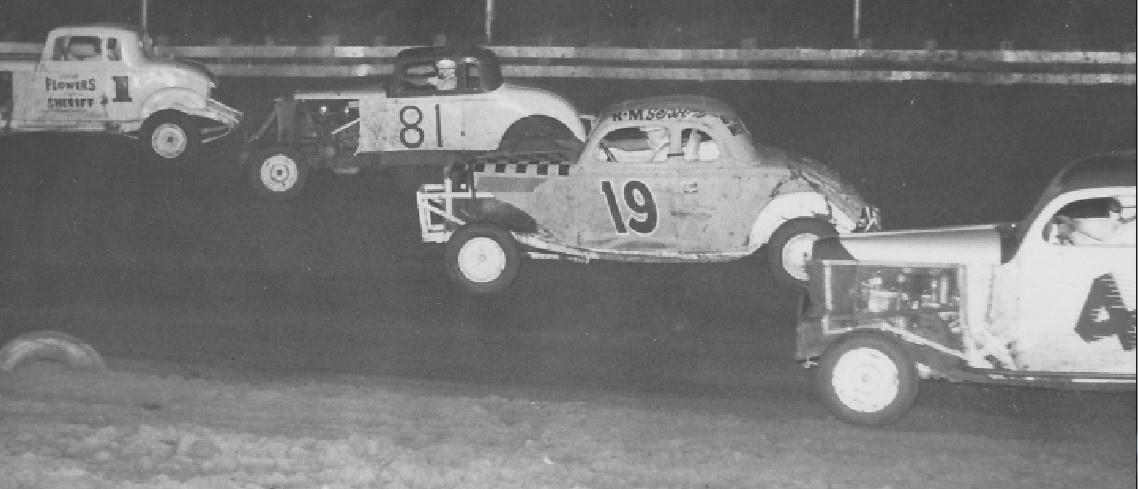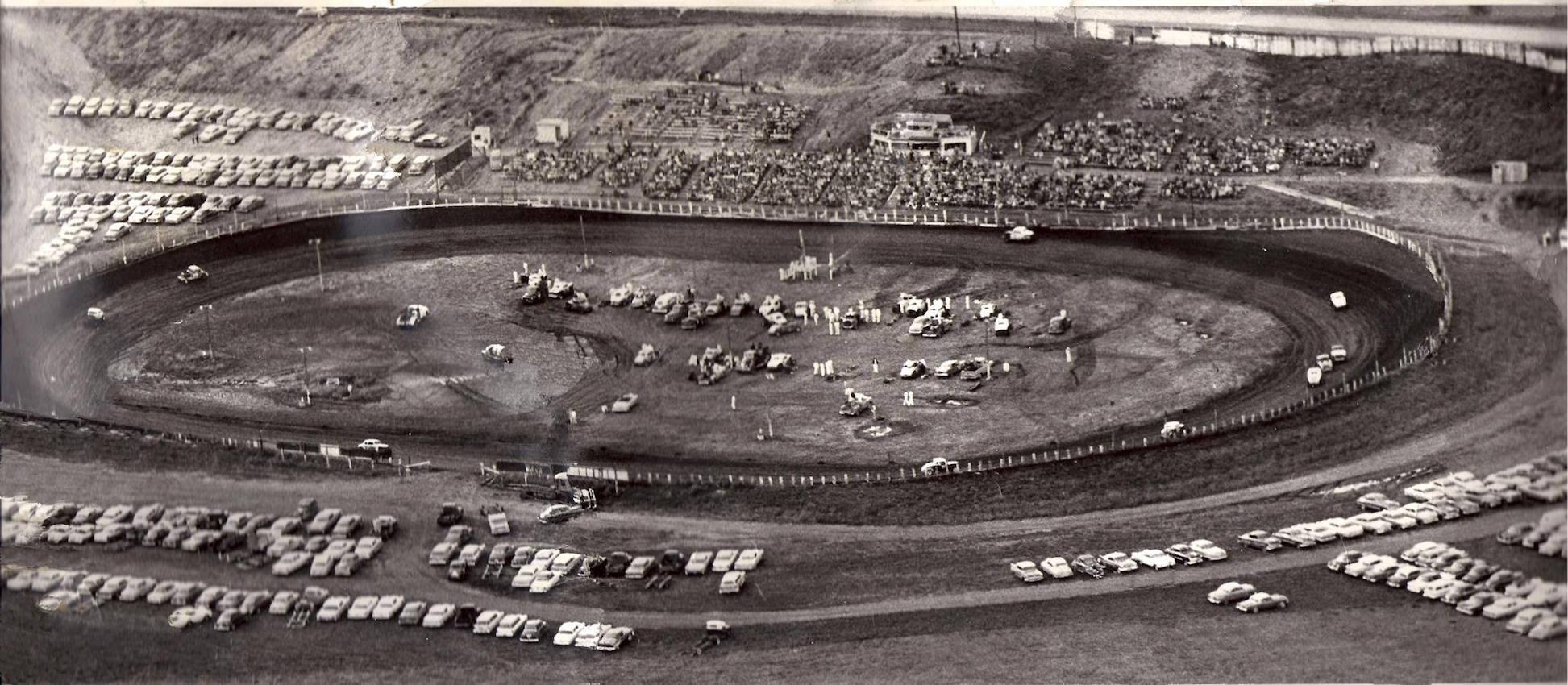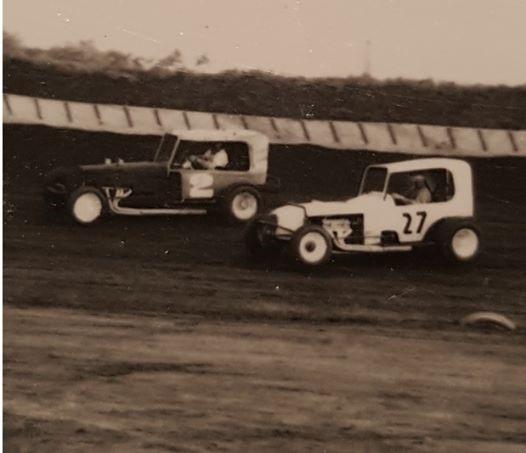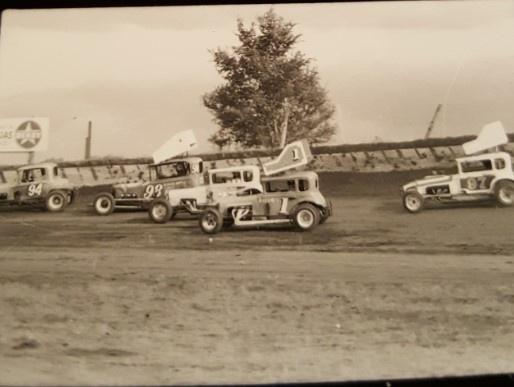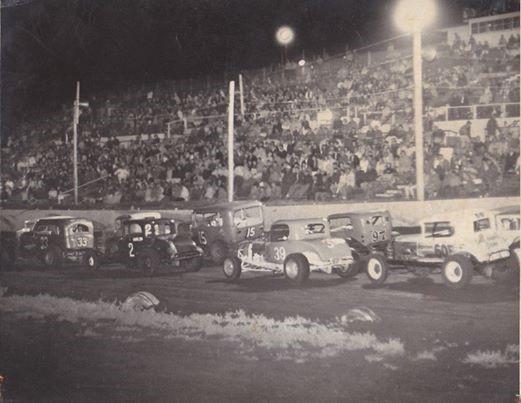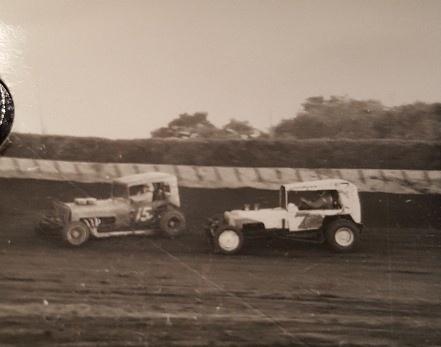Lori Walsh: It was in 1954 that soybean farmer Til Huset turned his field into a three-eighths mile dirt oval in Brandon, South Dakota. Huset's Speedway remained open for two seasons, but then sat empty for two years. In today's Images of the Past, we learn more about this track, and its deep racing history. Joining us is Tom Savage. Tom, welcome to In The Moment. Thanks for being here.
Tom Savage: Yes, good morning.
Lori Walsh: Also with us, Tom Savage, Jr. Tom Jr., thank you as well.
Tom Savage, Jr.: Yes, this is Tom Jr. Hello.
Lori Walsh: All right. I want to start with Tom Sr., and go back to the beginnings, and what we know about Til Huset, and this idea that the original track is, it's people on blankets just watching the race. It's uneven. It's in a field. Tell me how this all got started.
Tom Savage: Actually, Til Huset was a race car driver himself, done a little bit of racing in the '30s and the '40s. And one day, him and his son-in-law towed their race car down to Sioux City at the Riverview Stadium to watch the stock car races. And of course they didn't do very well, but Til was more impressed with how many people were there to watch, so he decided to build a race track.
Lori Walsh: Did people come, Tom Sr., during those first two years? Was it a big draw? It seems like a gutsy move to take farmland and turn it into a track.
Tom Savage: Well, to answer your first question, the turnout at the very first race was relatively good for the day. But you've got to realize that back in 1954, a racetrack looked nothing like it does today. There was no guard rail, no PA system, no lights, nothing. It was just a three-eighths mile dirt racetrack sitting out in the middle of a soybean field. The only creature comforts that they had were there were trees all along the hillside there, so people just spread their blankets and sat underneath the trees, I mean, sat in the shade of the trees. But they couldn't hardly see anything because it was so dusty, and they had a portable sound system. They couldn't hear anything, but it didn't make a difference. They couldn't see anything anyway. But I would guess that there was in the neighborhood of a thousand people at that first race.
Lori Walsh: Wow. Tom Jr., for most people thinking about Huset's today, which is now Badlands, which is now up for sale, tell me a little bit about the condition of the track today, and how its history plays into this story of who might be next to keep this place open.
Tom Savage, Jr.: Yeah, well, I was hired By Chuck Brennan to run the track when he bought it. So I was hired in 2015 and we did a major facelift on the place, and it really needed it. It had sat the same as it had been for several years. So the numbers vary, but it's certainly in the close to $10 million that we put into it. And while I was out there watching the renovation happen, my mind kept going back to 1954 and what it looked like. And my Dad was up there as a teenager and I thought about that a lot, just as we were doing this stuff.
It's quite a place now. If you haven't been out there since we did all the renovations, it's a magical place. It's got all the bells and whistles you could possibly imagine for a dirt track. And so just seeing it transform, and thinking about that almost every day, of what it looked like when Til Huset first built it and turned it into what we have now, it's pretty amazing. That place is set for many years. Hopefully that sale can go through, but it's quite a place now.
Lori Walsh: Yeah. Tom Sr., tell me about some of those teenage years and your early memories of the track. What are some of the highlights for you?
Tom Savage: Well, you've got to realize that back in those days, race cars were primarily all pre-war coupes and sedans, and they were built in a day or two. All they did was take the glass out of them, put roll bars in them, and they were ready to go racing. So there were a lot of race cars around then, and it was racing in its lost form. Most of the racers were World War II veterans and Korean War veterans, and after dodging bullets in World War II, they weren't a bit afraid to go out there and slam and bang cars around. It got pretty rough at times, a lot of cars got upside down, a lot of cars climbed over the walls, and a lot of fires, a lot of fist fights after the races. But boy, it sure was a lot of fun back in those days.
Lori Walsh: Any top drivers, or top races that you'll always remember? Who was really always good for a show?
Tom Savage: Well, in the very beginning, in the '50s, the [Stogsell 00:05:19] brothers from Wagner, South Dakota were very, very strong. [inaudible 00:05:24] from Pipestone was strong. As you move into the 60's, Jim Matthews became a very dominant racer. Into the '70s, in the sprint car racers, John Stevenson from Saint Paul, Minnesota won three consecutive championships out there. So it evolved from the '50s all the way up to the present time. There were outstanding drivers from different eras.
Lori Walsh: Tom Jr., take me back to your teenage years and some of your first, I mean, my first memory of Huset's is seeing the Beach Boys play there as a teenager, because it was a venue for other events. What were you doing at Huset's when you were the same age as when your dad discovered the place?
Tom Savage, Jr.: Yeah. I tell people a lot that my story is very similar to a lot of people in Sioux falls that just growing up out there. Just going out there every Sunday night, and running around and rolling around on those big Hills over there by turn four, which is now where we built that big suite. It's a big, beautiful building that we built, and while we were building that in 2015 and spring of 2016, I just, again, my memory got the best of me, or my emotions got the best of me watching that, but that was the very area where we used to roll around and run up and down those hills. And it's now this, multimillion dollar suite sitting there. So I just remember going out there, every Sunday night and watching, my dad mentioned Jim Matthews, which he wrote a book about Jim Matthews. So Jimmy was always my favorite driver. And just, I remember going out there, Saturday nights we went to Jackson, Minnesota, and Sunday nights we were at Huset's, and that's just how it was growing up.
Lori Walsh: Yeah, Tom Sr., when we think about a place like this, and the history that's there, but also the future, what does it mean for a community? Is it about a community of drivers? Is it about the community that goes to the races? What's the impact on a place like Huset's to the people who are devoted to it?
Tom Savage: Well, people involved in the automobile racing sport are a very close-knit fraternity of people. They're a bunch of blue collar people who, there've been racing cars ever since the second one was ever built, and they all believe that they can beat the other guy, and it's a man and his machine against man and his machine. As far as the community involvement, it has a tremendous economic involvement for the city of Brandon, as well as for Sioux Falls, because when they're racing out there on Sunday night, a lot of people come to Huset's for the racing on Sunday night.
Lori Walsh: Tom Sr., were those fist fights between drivers, or where they between the people in the crowd? In the rougher days, where did it get rough?
Tom Savage: Yes, yes. To both of them. A lot of times, back in those early days, back in the '50s, it was not uncommon to, if you couldn't pass a car, you just shoved him off that race track, get out of the way. And of course the guy who got shoved off couldn't wait for the race to get over so he could take it out on the driver who shoved him off. And by the same token, there were fans for both of those drivers up in the grandstand. I can remember fist fights in the grandstand over such maneuvers as out on the race track.
Lori Walsh: Yeah.
Tom Savage: It was wild and wooly back in the fifties.
Lori Walsh: Tom Jr., it sounds pretty slick, now. It sounds less wild and wooly, but still important, and when you look to the future, Tom Jr., of this place, what are your hopes? Clearly you hope there's a buyer and that races continue, but why does it matter? Now that the renovations have been done, what's the potential for this racetrack?
Tom Savage, Jr.: I've always thought it was really cool. I've put a list together of every driver who's ever raced at Huset's, and has also raced either in IndyCar, or NASCAR. And I know Huset's was built on what my father was saying, just the guys living on the East side of Sioux falls, and working at Morrell's, and growing up in Brandon, or Wagner, the area, and we'd go out there and race, and it still has that place, the weekend warrior place. It certainly has that, and there's still classes of cars that come out there. And I think that's important just to keep the fabric of the sport together, that that racetrack is there for them. But I'm also, I used to work at IndyCar, and I just, I find a real connection with guys who've raced at the racetrack I grew up at watching, and have also made it to the Indianapolis 500, and I think that's cool.
And I know it's a bucket list racetrack for guys at the highest level. I can assure you. When Tony Stewart was racing NASCAR long before he ever raced at Huset's, he did one time in 20014, 13 or 14, but he came to Sioux falls when he was racing for Joe Gibbs Racing, and the side of the race car said Home Depot on it. And he was doing a national tour of going around to all these Home Depots around the country, and when they landed in Sioux Falls, the first thing they did is drove out to Huset's, just because he wanted to see it. Didn't even race there, he just drove out and wanted to look at it, and then they went to their Home Depot appearance in Sioux falls. And then a few years later, he came back and raced it one night.
So it's people in the racing industry, at IndyCar, NASCAR, no matter the level they know of Huset's Speedway in Brandon, South Dakota. So I hope that it just continues to grow, and continues to grow. And I'm happy that the sale looks positive that it's going to happen, and the name's going back to Huset's, and I just think it's important for the lineage of the sport.
Lori Walsh: Tom Savage, Jr. and Tom Savage, Sr. talking for Images of the Past today about Huset's Speedway in Southeast South Dakota. Thank you so much. We appreciate your time.
Tom Savage: Thank you.
Tom Savage, Jr.: Thank you very much.



